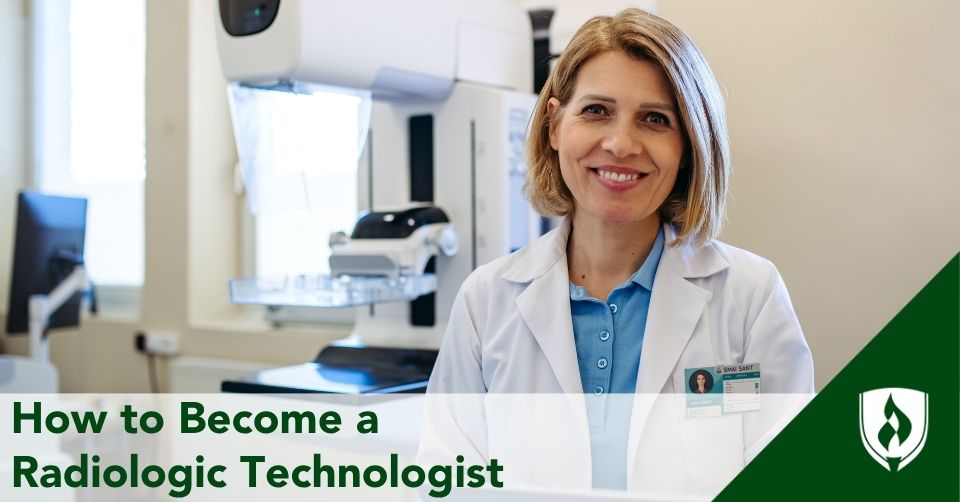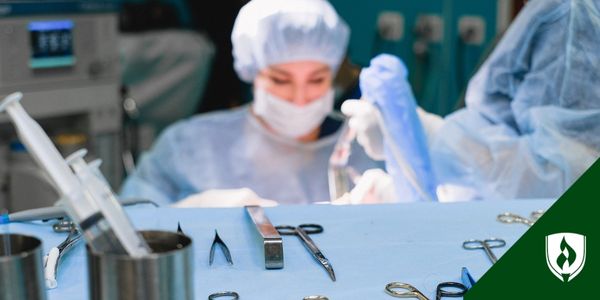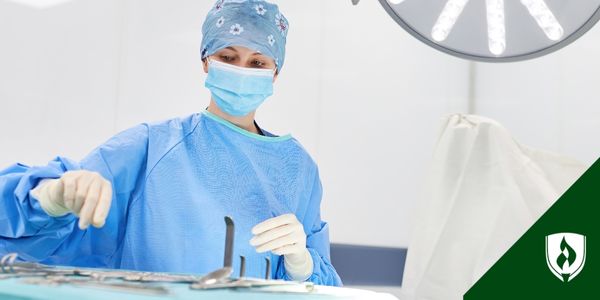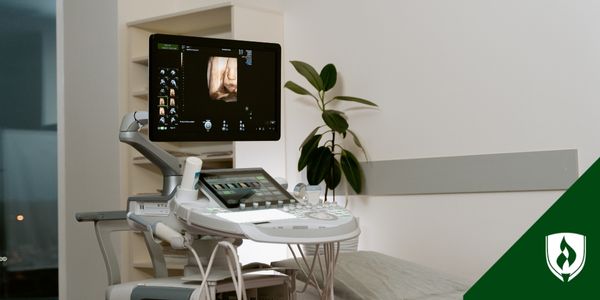How to Become a Radiologic Technologist
09/05/2025

Starting a career as a radiologic technologist puts you at the heart of healthcare, where you can play a hands-on role in producing medical images that guide patient treatment. Becoming a registered radiologic technologist involves completing an accredited program, gaining clinical experience, and earning certification to work confidently with imaging equipment.
From operating X-ray and computed tomography machines to specializing in magnetic resonance imaging or radiation therapy, each step prepares you to provide essential patient care while advancing your career in a rapidly evolving field.
Step One: Enroll in an Accredited Radiologic Technology Program
The first move toward becoming a registered technologist is enrolling in an accredited radiologic technology program.1 These programs provide the essential mix of knowledge and hands-on skill-building to prepare you for the realities of patient-facing healthcare work.
At Rasmussen University, you can start building your future in radiologic technology with a JRCERT-accredited program1 designed to help students meet ARRT eligibility requirements. The curriculum emphasizes real-world relevance blending online coursework with hands-on experience at clinical sites, on-campus lab and diverse clinical practicum settings.
Students gain experience in:
- Accurate anatomical imaging: Apply foundational knowledge in anatomy and physiology to adapt exams to each patient for precise images.
- Radiographic equipment operation: Use different types of equipment like practicing radiographic technologists and evaluate technical factors to perform diagnostic imaging exams.
- Adherence to safety standards: Follow radiation safety practices for patients and personnel.
- Patient care and positioning: Accurately assess patient sensitivity and condition to modify procedures as needed while keeping patients informed along the way.
This program is built for students who are ready to step confidently into the field and want the structure and support to get there.
Step Two: Gain Real-World Experience Through Clinical Rotations
During the program, students at Rasmussen take part1 in clinical rotations at clinical sites, on-campus labs, and diverse clinical practicum settings where they engage in the day-to-day responsibilities of radiologic technologists. These rotations are a crucial part of learning, offering students a hands-on introduction to radiologic imaging in diverse clinical settings. This experience helps prepare them for a successful career as radiologic technologists.
You won’t just observe. Rasmussen’s clinical training model empowers students to practice, problem-solve, and perform under supervision, preparing them to step into their first job with confidence.
Step Three: Become a Registered Radiologic Technologist
After completing your education, the next step is earning professional certification2 through the American Registry of Radiologic Technologists (ARRT). Graduates from Rasmussen’s program1 are prepared to sit for the radiography exam, a national credential that many employers require when hiring registered radiologic technologists.
To become certified, you must:2
- Graduate from a JRCERT-accredited radiologic technology program
- Pass the ARRT radiography exam
- Adhere to ARRT’s professional ethics and ongoing education requirements
Once you’ve passed the exam, you officially become a registered technologist, qualified to work in a wide variety of healthcare facilities. Rasmussen’s curriculum1 is aligned with ARRT content specifications, ensuring students build the knowledge and skills necessary for success.
Step Four: Choose a Specialization and Keep Building Your Career
After gaining experience as a general radiologic technologist, many professionals choose to expand their skillset through certifications in specialties, such as:3
- Magnetic Resonance Imaging (MRI)
- Computed Tomography (CT)
- Mammography (breast tissue imaging)
- Bone Densitometry
- Vascular Interventional Radiography
- Radiation Therapy
These specialized areas offer opportunities to deepen your technical skills and serve more complex patient needs. Rasmussen University helps students explore1 these pathways early by introducing foundational concepts in these specialties.
Whether your goal is to advance into management, shift into education, or focus on a specific patient population, Rasmussen can help you chart a personalized career path forward.
Step Five: Pursue Continued Education and Certification Maintenance
The radiologic sciences are constantly evolving. New technologies, protocols, and procedures require professionals to stay current.4 Through Rasmussen’s emphasis on lifelong learning, students leave the program equipped not just for their first job, but for a career that grows with them.
To maintain ARRT certification, you’ll need to:5
- Complete continuing education credits
- Stay updated on new diagnostic imaging methods
- Renew credentials every two years
Many registered radiologic technologists return to school later to pursue bachelor’s degrees or advanced certifications.
Rasmussen University students who earn an associate degree1 in Radiologic Technology can also choose to continue their education by transferring credits into Rasmussen’s Health and Wellness bachelor’s degree.6
Where Radiologic Technologists Work
As a radiologic technologist, you could work in a range of healthcare environments, such as:7
- Hospitals and trauma centers
- Private imaging centers
- Physicians’ offices
- Outpatient clinics
- Urgent care or orthopedic facilities
Rasmussen prepares students for the realities of these settings by combining clinical experiences with simulations and labs using computerized equipment and X-ray equipment mirroring what you’ll find on the job.
Responsibilities may include:8
- Preparing and positioning patients for imaging exams
Explaining procedures and ensuring comfort - Producing high-quality diagnostic imaging for physician review
- Practicing meticulous radiation safety techniques
- Working alongside radiologists and nurses to deliver efficient care
This role demands not only technical knowledge but also compassion, critical thinking, and the ability to work closely with patients under sometimes stressful conditions.
Radiologic Technology Program Highlights at Rasmussen University
Rasmussen University stands out with a career-focused approach that blends academic rigor with practical experience.
Students benefit from:1
- A JRCERT-accredited program with access to the current accreditation award letter
- Supportive faculty with experience in medical imaging, radiation therapy, and healthcare operations
- Hands-on experience at clinical sites, on-campus labs, and diverse clinical practicum settings
- Online flexibility combined with real-world learning
- A curriculum aligned with ARRT certification requirements and informed by employer needs
If you’re just starting out or changing careers, Rasmussen offers a guided path to becoming a skilled, confident technologist with student services, career support, and faculty who care about your success.
Take the Next Step in Radiologic Technology
If you’re serious about launching a career in radiologic technology, the best time to act is now. With growing demand for imaging professionals across the country, enrolling in a program like Rasmussen’s can set you on a clear and actionable path.
From your first anatomy class to your final clinical rotation, Rasmussen’s radiologic technology program is designed to help you complete your education, earn your certification, and start making a difference in patients’ lives.
1Rasmussen University, “Radiologic Technology,” Rasmussen University, https://www.rasmussen.edu/degrees/health-sciences/radiologic-technology/ (accessed August 1, 2025).
2American Registry of Radiologic Technologists (ARRT), “ARRT Certification and Registration,” ARRT, https://www.arrt.org/pages/about-the-profession/arrt-certification-and-registration (accessed August 1, 2025).
3American Society of Radiologic Technologists (ASRT), “Specialty Careers in Radiologic Technology,” ASRT, https://www.asrt.org/main/career-center/careers-in-radiologic-technology (accessed August 1, 2025).
4U.S. Bureau of Labor Statistics, “Radiologic Technologists: Job Outlook,” Occupational Outlook Handbook, https://www.bls.gov/ooh/healthcare/radiologic-technologists.htm#tab-4 (accessed August 1, 2025). Employment conditions in your area may vary.
5American Registry of Radiologic Technologists (ARRT), “Maintaining Credentials,” ARRT, https://www.arrt.org/pages/resources/maintaining-credentials (accessed August 1, 2025).
6Rasmussen University, “Health and Wellness,” Rasmussen University, https://www.rasmussen.edu/degrees/health-sciences/health-wellness/ (accessed August 1, 2025).
7U.S. Bureau of Labor Statistics, “Radiologic Technologists: Work Environment,” Occupational Outlook Handbook, https://www.bls.gov/ooh/healthcare/radiologic-technologists.htm#tab-3 (accessed August 1, 2025). Employment conditions in your area may vary.
8U.S. Bureau of Labor Statistics, “Radiologic Technologists: What They Do,” Occupational Outlook Handbook, https://www.bls.gov/ooh/healthcare/radiologic-technologists.htm#tab-2 (accessed August 1, 2025). Employment conditions in your area may vary.



